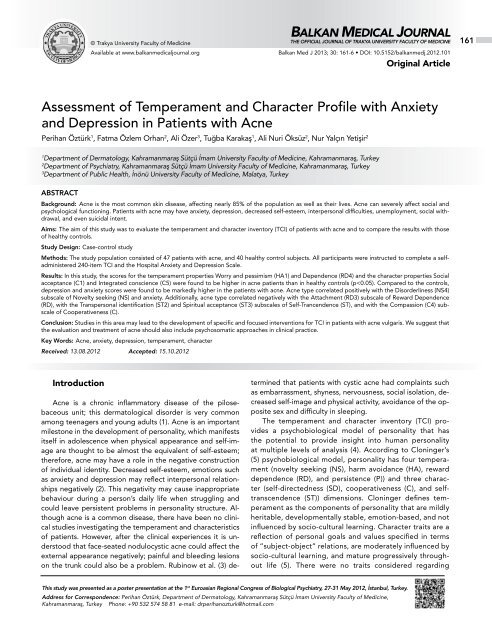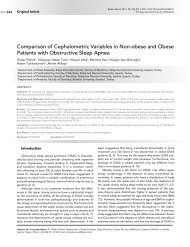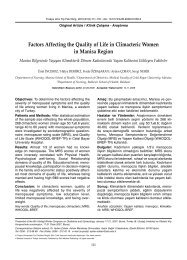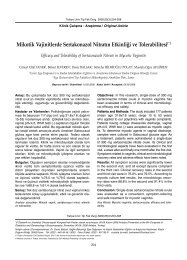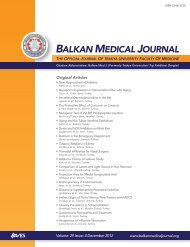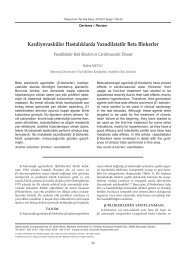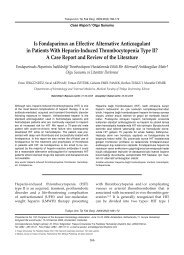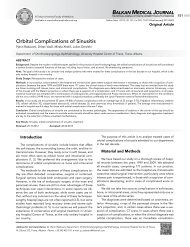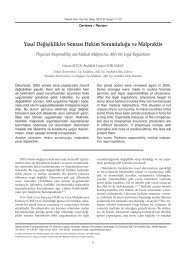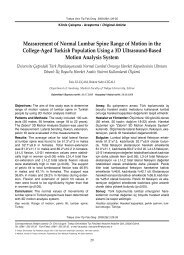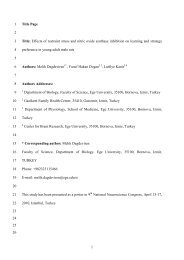Assessment of Temperament and Character Profile with Anxiety and ...
Assessment of Temperament and Character Profile with Anxiety and ...
Assessment of Temperament and Character Profile with Anxiety and ...
You also want an ePaper? Increase the reach of your titles
YUMPU automatically turns print PDFs into web optimized ePapers that Google loves.
© Trakya University Faculty <strong>of</strong> Medicine<br />
Available at www.balkanmedicaljournal.org<br />
BALKAN MEDICAL JOURNAL<br />
THE OFFICIAL JOURNAL OF TRAKYA UNIVERSITY FACULTY OF MEDICINE<br />
Balkan Med J 2013; 30: 161-6 • DOI: 10.5152/balkanmedj.2012.101<br />
Original Article<br />
161<br />
<strong>Assessment</strong> <strong>of</strong> <strong>Temperament</strong> <strong>and</strong> <strong>Character</strong> Pr<strong>of</strong>ile <strong>with</strong> <strong>Anxiety</strong><br />
<strong>and</strong> Depression in Patients <strong>with</strong> Acne<br />
Perihan Öztürk 1 , Fatma Özlem Orhan 2 , Ali Özer 3 , Tuğba Karakaş 1 , Ali Nuri Öksüz 2 , Nur Yalçın Yetişir 2<br />
1<br />
Department <strong>of</strong> Dermatology, Kahramanmaraş Sütçü İmam University Faculty <strong>of</strong> Medicine, Kahramanmaraş, Turkey<br />
2<br />
Department <strong>of</strong> Psychiatry, Kahramanmaraş Sütçü İmam University Faculty <strong>of</strong> Medicine, Kahramanmaraş, Turkey<br />
3<br />
Department <strong>of</strong> Public Health, İnönü University Faculty <strong>of</strong> Medicine, Malatya, Turkey<br />
ABSTRACT<br />
Background: Acne is the most common skin disease, affecting nearly 85% <strong>of</strong> the population as well as their lives. Acne can severely affect social <strong>and</strong><br />
psychological functioning. Patients <strong>with</strong> acne may have anxiety, depression, decreased self-esteem, interpersonal difficulties, unemployment, social <strong>with</strong>drawal,<br />
<strong>and</strong> even suicidal intent.<br />
Aims: The aim <strong>of</strong> this study was to evaluate the temperament <strong>and</strong> character inventory (TCI) <strong>of</strong> patients <strong>with</strong> acne <strong>and</strong> to compare the results <strong>with</strong> those<br />
<strong>of</strong> healthy controls.<br />
Study Design: Case-control study<br />
Methods: The study population consisted <strong>of</strong> 47 patients <strong>with</strong> acne, <strong>and</strong> 40 healthy control subjects. All participants were instructed to complete a selfadministered<br />
240-item TCI <strong>and</strong> the Hospital <strong>Anxiety</strong> <strong>and</strong> Depression Scale.<br />
Results: In this study, the scores for the temperament properties Worry <strong>and</strong> pessimism (HA1) <strong>and</strong> Dependence (RD4) <strong>and</strong> the character properties Social<br />
acceptance (C1) <strong>and</strong> Integrated conscience (C5) were found to be higher in acne patients than in healthy controls (p
162<br />
Öztürk et al.<br />
<strong>Temperament</strong> <strong>and</strong> <strong>Character</strong> Pr<strong>of</strong>ile in Acne<br />
Balkan Med J<br />
2013; 30: 161-6<br />
working temperament <strong>and</strong> character when exploring the<br />
literature <strong>of</strong> patients <strong>with</strong> acne.<br />
The aim <strong>of</strong> the presented study was to examine whether<br />
patients <strong>with</strong> acne have common specific personality traits (as<br />
evaluated by the TCI self-report questionnaire) <strong>and</strong> if there is<br />
any relationship between the TCI scores <strong>and</strong> depression <strong>and</strong><br />
anxiety.<br />
Material <strong>and</strong> Methods<br />
Forty healthy volunteers <strong>and</strong> 47 patients <strong>with</strong> acne, who<br />
were referred to our dermatology outpatient clinic between<br />
the January-December 2011, were included in the study.<br />
Inclusion criteria for patients<br />
Patients were over the age <strong>of</strong> 18, diagnosed <strong>with</strong> acne,<br />
literate, did not have any systemic or metabolic diseases,<br />
had no dermatological diseases other than acne, <strong>and</strong> an<br />
absence <strong>of</strong> dementia, mental retardation, cognitive impairment,<br />
the presence <strong>of</strong> recurrent suicidal thoughts, psychotic<br />
illness, psychiatric drug-use, advanced neurological diseases<br />
<strong>and</strong> decompensated systemic diseases. Primarily, patients<br />
<strong>with</strong> acne who visited our dermatology clinic were informed<br />
about the study <strong>and</strong> were asked whether they agreed to participate.<br />
Following examination, the doctor decided if the<br />
patients who agreed to participate in the study befit the<br />
study criteria. Patients who do not meet the criteria were not<br />
included in the study. After examination in the dermatology<br />
clinic, patients diagnosed <strong>with</strong> acne vulgaris <strong>and</strong> who chose<br />
to participate in the study were assessed, <strong>and</strong> the following<br />
demographics were noted: age, gender, education level,<br />
marital status <strong>and</strong> duration <strong>of</strong> acne; routine blood chemistries<br />
(glucose, urea, creatinine, ALT, AST) <strong>and</strong> hormone tests<br />
(FSH, LH, oestrogen, progesterone, free testosterone, DHE-<br />
SO4, prolactin) were done. Patients who had abnormalities<br />
in these tests were not included in the study. According to<br />
the type <strong>of</strong> acne, patients were divided into three groups:<br />
mild (mainly comedones), moderate (in addition to comedones,<br />
papules <strong>and</strong> pustules mainly) <strong>and</strong> severe (comedones,<br />
papules, pustules, nodules <strong>and</strong> cystic lesions in addition). According<br />
to the localisation, patients were divided into two<br />
groups: face involvement <strong>and</strong> face <strong>and</strong> body involvement. 47<br />
patients who complied <strong>with</strong> the criteria were included in the<br />
study. For the diagnosis <strong>of</strong> the patients, SCID I (Structured<br />
Clinical Interview for DSM-IV) criteria, developed from the<br />
DSM-IV criteria, were used.<br />
For the control group, volunteers who were not diagnosed<br />
<strong>with</strong> acne vulgaris or any systemic, metabolic or psychiatric<br />
illness were included. After recording the sociodemographic<br />
characteristics <strong>of</strong> patients <strong>and</strong> the control group, the Hospital<br />
<strong>Anxiety</strong> <strong>and</strong> Depression Scale (HAD) <strong>and</strong> TCI were applied.<br />
Ethical Considerations<br />
This study was approved by the ethics committee <strong>of</strong><br />
Kahramanmaraş Sütçüimam University School <strong>of</strong> Medicine <strong>and</strong><br />
conducted according to the ethical st<strong>and</strong>ards <strong>of</strong> the Helsinki<br />
Declaration <strong>of</strong> 2000. All subjects signed a written informed<br />
consent.<br />
Measures<br />
<strong>Temperament</strong> <strong>and</strong> <strong>Character</strong> Inventory (TCI): This selfreported<br />
scale consists <strong>of</strong> 240 items <strong>with</strong> “true” or “false” as<br />
the response options; it can be applied to individuals aged<br />
18 years old or older. The TCI consists <strong>of</strong> seven main scales<br />
formed by four dimensions <strong>of</strong> temperament (NS, HA, RD <strong>and</strong><br />
P) <strong>and</strong> 3 dimensions <strong>of</strong> character (SD, C <strong>and</strong> ST), along <strong>with</strong><br />
24 subscales <strong>of</strong> these scales. It has been commonly used in<br />
different areas <strong>of</strong> psychological <strong>and</strong> psychiatric research <strong>and</strong><br />
practice in the last 10 years. The TCI was developed by Cloninger<br />
(5) <strong>and</strong> the Turkish version <strong>of</strong> the TCI has been validated<br />
by Kose et al. (6, 7).<br />
The Hospital <strong>Anxiety</strong> <strong>and</strong> Depression Scale: The HAD<br />
Scale is a self-reported questionnaire for hospital out-patients<br />
in medical or surgical departments used to assess anxiety <strong>and</strong><br />
depression as two dimensions (8). The score for each subscale<br />
ranges from zero to 21: the higher the score, the worse the<br />
status, <strong>with</strong> respect to that particular category (9). The validation<br />
<strong>and</strong> reliability studies <strong>of</strong> the HAD Scale developed by<br />
Zigmond <strong>and</strong> Snaith (1983), were carried out by Aydemir et al.<br />
(10). The HAD scale has been prepared to screen for anxiety<br />
<strong>and</strong> depression in patients <strong>with</strong> physical disease, <strong>and</strong> contains<br />
anxiety <strong>and</strong> depression subscales. The cut-<strong>of</strong>f points in the<br />
Turkish version <strong>of</strong> the scale are 10 for the anxiety subscale <strong>and</strong><br />
7 for the depression subscale.<br />
Statistical analyses<br />
Data were computerised using the Statistical Packages for<br />
the Social Sciences (SPSS v.15.0; SPSS Inc., Chicago, IL, USA).<br />
The data were not normally distributed according to the Kolmogorov-Smirnov<br />
test (p
Balkan Med J<br />
2013; 30: 161-6<br />
Öztürk et al.<br />
<strong>Temperament</strong> <strong>and</strong> <strong>Character</strong> Pr<strong>of</strong>ile in Acne<br />
163<br />
Table 1. Socio-demographic variables <strong>of</strong> patients <strong>and</strong> controls<br />
Acne Control p<br />
n=47 (%) n=40 (%)<br />
Sex 0.38<br />
Female 39 (83) 33 (82.5)<br />
Male 8 (17) 7 (17.5)<br />
Occupation 0.49<br />
Worker 4 (8.5%) 2 (5%)<br />
Jobless 1 (2.1%) 2 (5%)<br />
Housewife 4 (8.5%) 2 (5%)<br />
Student 38 (80.8%) 32 (80%)<br />
Education<br />
Primary 15 (29.8%) 10 (25%)<br />
High school 20 (42.6%) 16 (40%)<br />
University 12 (25.5%) 14 (35%)<br />
Age min, m, max 16- 20- 26 17- 24- 47 0.00<br />
Min, m, max: minimum, median, maximum<br />
in healthy controls (p0.05) (Table 2).<br />
Depression <strong>and</strong> anxiety scores were significantly higher in<br />
patients <strong>with</strong> acne compared to the control group (p
164<br />
Öztürk et al.<br />
<strong>Temperament</strong> <strong>and</strong> <strong>Character</strong> Pr<strong>of</strong>ile in Acne<br />
Balkan Med J<br />
2013; 30: 161-6<br />
Table 3. Comparison <strong>of</strong> average HAD scores between acne<br />
patients <strong>and</strong> healthy controls<br />
Acne Control p<br />
n=47 (%) n=40 (%)<br />
HAD-A 1-10-17 2-7-15 0.001<br />
HAD-D 1-5-17 1-3-11
Balkan Med J<br />
2013; 30: 161-6<br />
Öztürk et al.<br />
<strong>Temperament</strong> <strong>and</strong> <strong>Character</strong> Pr<strong>of</strong>ile in Acne<br />
165<br />
Cooperativeness refers to social acceptance, empathy,<br />
helpfulness, compassion, <strong>and</strong> pure-hearted principles. Individuals<br />
<strong>with</strong> a high level <strong>of</strong> C are described as reasonable,<br />
compassionate, empathetic, helpful, <strong>and</strong> principled (5, 25). As<br />
shown in many previous studies, as well as in our study, depression<br />
<strong>and</strong> anxiety scores showed a negative correlation <strong>with</strong> C.<br />
In our study, the negative correlation seen between increasing<br />
severity <strong>of</strong> acne <strong>and</strong> C may be interpreted as a worsening <strong>of</strong><br />
the person’s external appearance, which may cause social intolerance<br />
<strong>and</strong> an increased susceptibility to depression.<br />
When interpreting our results, it is important to note some<br />
limitations <strong>of</strong> our study. First, our sample size was relatively small;<br />
hence, it may not be representative <strong>of</strong> all acne patients. Further<br />
studies are required to confirm these results in larger clinical<br />
samples. We can draw no conclusions about cause-<strong>and</strong>-effect<br />
relationships because <strong>of</strong> the cross-sectional nature <strong>of</strong> the data.<br />
Finally, we used self-reported questionnaires to evaluate<br />
psychiatric symptoms; clinician-administered structured interviews<br />
<strong>and</strong> scales could yield more reliable findings. In conclusion,<br />
this study suggests that acne patients have distinctive<br />
temperament dimensions compared to healthy controls.<br />
Further studies are needed to determine the relationship<br />
between patterns <strong>of</strong> temperament <strong>and</strong> character dimensions<br />
<strong>and</strong> acne, including following successful treatment <strong>and</strong> longitudinal<br />
courses <strong>of</strong> patients. As <strong>with</strong> other psychosomatic<br />
disorders, in acne vulgaris, it will be incomplete to examine<br />
only the psychiatric condition <strong>and</strong> personality characteristics.<br />
Within the framework <strong>of</strong> a multifactorial disease model, environmental<br />
<strong>and</strong> emotional issues add to the genetic <strong>and</strong> characteristic<br />
floor, which can lead to increased sebum <strong>and</strong> can be<br />
considered to cause <strong>and</strong> aggravate acne.<br />
In addition to the role <strong>of</strong> psychological factors during the<br />
start, aggravation <strong>and</strong> healing <strong>of</strong> disease, disorders that affect<br />
body image have important affects on temperament <strong>and</strong><br />
character. It is important to approach the disease according to<br />
the biopsycosocial-medical model <strong>with</strong>in the framework <strong>and</strong><br />
to plan the treatment by considering this.<br />
Ethics Committee Approval: Ethics committee approval was received<br />
for this study from the ethics committee <strong>of</strong> Kahramanmaraş<br />
Sütçü İmam University School <strong>of</strong> Medicine.<br />
Informed Consent: Written informed consent was obtained from patients<br />
who participated in this study.<br />
Peer-review: Externally peer-reviewed.<br />
Author contributions: Concept – P.Ö., F.Ö.O.; Design - P.Ö., F.Ö.O.;<br />
Supervision - P.Ö., F.Ö.O.; Resource - T.K., A.N.Ö., N.Y.Y.; Materials<br />
- T.K., A.N.Ö., N.Y.Y.; Data Collection&/or Processing - T.K., A.N.Ö.,<br />
N.Y.Y.; Analysis&/or Interpretation - A.Ö.; Literature Search - P.Ö.;<br />
Writing - P.Ö.; Critical Reviews - P.Ö., F.Ö.O.<br />
Conflict <strong>of</strong> Interest: No conflict <strong>of</strong> interest was declared by the authors.<br />
Financial Disclosure: No financial disclosure was declared by the authors.<br />
References<br />
1. Demirçay Z, Senol A, Seckin D, Demir F. Reliability <strong>of</strong> Turkish version<br />
<strong>of</strong> acne quality <strong>of</strong> life scale in patients <strong>with</strong> acne vulgaris.<br />
Türkderm 2006;40:94-7.<br />
2. Rapp DA, Brenes GA, Feldman SR, Fleischer AB Jr, Graham GF,<br />
Dailey M, et al. Anger <strong>and</strong> acne: implications for quality <strong>of</strong> life,<br />
patient satisfaction <strong>and</strong> clinical care. Br J Dermatol 2004;151:<br />
183-9. [CrossRef]<br />
3. Rubinow DR, Peck GL, Squillace KM, Gantt GG. Reduced anxiety <strong>and</strong><br />
depression in cystic acne patients after successful treatment <strong>with</strong> oral<br />
isotretinoin. J Am Acad Dermatol 1987;17:25-32. [CrossRef]<br />
4. Dzamonja-Ignjatovic T, Svrakic DM, Svrakic N, Jovanovic MD,<br />
Cloninger RC. Cross-cultural validation <strong>of</strong> the revised <strong>Temperament</strong><br />
<strong>and</strong> <strong>Character</strong> Inventory: Serbian data. Compr Psychiatry<br />
2010;51:649-55. [CrossRef]<br />
5. Cloninger CR, Svrakic DM, Przybeck TR. A psychobiological<br />
model <strong>of</strong> temperament <strong>and</strong> character. Arch Gen Psychiatry<br />
1993;50:975-90. [CrossRef]<br />
6. Kose S, Sayar K, Kalelioglu U, et al. The Turkish version <strong>of</strong> the TCI:<br />
reliability, validity, <strong>and</strong> factorial structure. Bulletin Clinical Psychopharmacology<br />
2004;14:107-31.<br />
7. Kose S, Sayar K, Kalelioglu U, Aydin N, Celikel FC, Gulec H, et al.<br />
Normative data <strong>and</strong> factorial structure <strong>of</strong> the Turkish version <strong>of</strong><br />
the <strong>Temperament</strong> <strong>and</strong> <strong>Character</strong> Inventory (TCI). Compr Psychiatry<br />
2009;50:361-8. [CrossRef]<br />
8. Aydemir O. Validity <strong>and</strong> Reliability <strong>of</strong> Turkish Version <strong>of</strong> Hospital<br />
<strong>Anxiety</strong> <strong>and</strong> Depression Scale. Turkish J Psychiatry 1997;8:280-7.<br />
9. Zigmond AS, Snaith RP. The hospital anxiety <strong>and</strong> depression<br />
scale. Acta Psychiatr Sc<strong>and</strong> 1983;67:361-70. [CrossRef]<br />
10. Aydemir O, Guvenir T, Kuey L. Turkish version <strong>of</strong> hospital anxiety<br />
<strong>and</strong> depression scale. Turkish J Psychiatry 1997;8:280-7.<br />
11. Jones-Caballero M, Chren MM, Soler B, Pedrosa E, Peñas PF.<br />
Quality <strong>of</strong> life in mild to moderate acne: relationship to clinical<br />
severity <strong>and</strong> factors influencing change <strong>with</strong> treatment. J Eur<br />
Acad Dermatol Venereol 2007;21:219-26. [CrossRef]<br />
12. John KOO. Psychodermatology: A practical manual for clinicians.<br />
Curr Probl Dermatol 1995;7:204-32. [CrossRef]<br />
13. Lim CC, Tan TC. Personality, disability <strong>and</strong> acne in college students.<br />
Clin Exp Dermatol 1991;16:371-3. [CrossRef]<br />
14. Finlay AY. Quality <strong>of</strong> life measurement in dermatology: a practical<br />
guide. Br J Dermatol 1997;136:305-14. [CrossRef]<br />
15. Klassen AF, Newton JN, Mallon E. Measuring quality <strong>of</strong> life in people<br />
referred for specialist care <strong>of</strong> acne: comparing generic <strong>and</strong> diseasespesific<br />
measures. J Am Acad Dermatol 2000;43:229-33. [CrossRef]<br />
16. Takahashi N, Suzukamo Y, Nakamura M, Miyachi Y, Green J, Ohya<br />
Y, et al. Japanese version <strong>of</strong> the Dermatology Life Quality Index:<br />
validity <strong>and</strong> reliability in patients <strong>with</strong> acne. Health Qual Life Outcomes<br />
2006;4:46-52. [CrossRef]<br />
17. Thomas DR. Psychosocial effects <strong>of</strong> acne. J Cutan Med Surg<br />
2005;4:3-5. [CrossRef]<br />
18. Gupta MA, Gupta AK. Depression <strong>and</strong> suicidal ideation in dermatology<br />
patients <strong>with</strong> acne, alopecia areata, atopic dermatitis <strong>and</strong><br />
psoriasis. Br J Dermatol 1998;139:846-50. [CrossRef]<br />
19. Fried RG, Gupta MA, Gupta AK. Depression <strong>and</strong> skin disease.<br />
Dermatol Clin 2005;23:657-64. [CrossRef]<br />
20. Fried RG, Wechsler A. Psychological problems in the acne patient.<br />
Dermatol Ther 2006;19:237-40. [CrossRef]<br />
21. Baz K, Yazıcı K, Köktürk A, et al. Effects <strong>of</strong> isotretinoin treatment<br />
on dermatological quality <strong>of</strong> life <strong>and</strong> anxiety/depression inpatients<br />
<strong>with</strong> severe acne. T Klin J Dermatol 2004;14:75-9.<br />
22. Ozcan Y, Ozcan H, Unal S. Personality <strong>Character</strong>istics in Patients<br />
<strong>with</strong> Acne Vulgaris. Klinik Psikiatri 2000;3:56-60.<br />
23. Kellett SC, Gawkrodker DJ. The psychological <strong>and</strong> emotional impact<br />
<strong>of</strong> acne <strong>and</strong> the effect <strong>of</strong> treatment <strong>with</strong> isotretinoin. Br J<br />
Dermatol 1999;140:273-82. [CrossRef]<br />
24. Kiliç A, Güleç MY, Gül U, Güleç H. <strong>Temperament</strong> <strong>and</strong> character<br />
pr<strong>of</strong>ile <strong>of</strong> patients <strong>with</strong> psoriasis. J Eur Acad Dermatol Venereol<br />
2008;22:537-42. [CrossRef]
166<br />
Öztürk et al.<br />
<strong>Temperament</strong> <strong>and</strong> <strong>Character</strong> Pr<strong>of</strong>ile in Acne<br />
Balkan Med J<br />
2013; 30: 161-6<br />
25. Cloninger CR. A systematic method for clinical description <strong>and</strong><br />
classification <strong>of</strong> personality variants. A proposal. Arch Gen Psychiatry<br />
1987;44:573-88. [CrossRef]<br />
26. Gencay-Can A, Can SS. <strong>Temperament</strong> <strong>and</strong> character pr<strong>of</strong>ile <strong>of</strong><br />
patients <strong>with</strong> fibromyalgia. Rheumatol Int 2012;32:3957-61.<br />
[CrossRef]<br />
27. Boz C, Gazioglu S, Altunayoglu V, Hocaoglu C. Effect <strong>of</strong> serotonergic<br />
antidepressant therapy on temperament <strong>and</strong> character<br />
scales in patients <strong>with</strong> chronic tension-type headache. Psychiatry<br />
Clin Neurosci 2007;61:534-42. [CrossRef]<br />
28. Sasayama D, Hori H, Teraishi T, Hattori K, Ota M, Matsuo J, et<br />
al. Difference in <strong>Temperament</strong> <strong>and</strong> <strong>Character</strong> Inventory scores between<br />
depressed patients <strong>with</strong> bipolar II <strong>and</strong> unipolar major depressive<br />
disorders. J Affect Disord 2011;132:319-24. [CrossRef]<br />
29. Brown SL, Svrakic DM, Przybeck TR, Cloninger CR. The relationship<br />
<strong>of</strong> personality to mood <strong>and</strong> anxiety states: a dimensional<br />
approach. J Psychiatr Res 1992;26:197-211. [CrossRef]<br />
30. Svrakic DM, Whitehead C, Przybeck TR, Cloninger CR. Differential<br />
diagnosis <strong>of</strong> personality disorders by the seven-factor model<br />
<strong>of</strong> temperament <strong>and</strong> character. Arch Gen Psychiatry 1993;50:<br />
991-9. [CrossRef]<br />
31. Jyllhä P, Isometsä P. <strong>Temperament</strong>, character <strong>and</strong> symptoms <strong>of</strong><br />
anxiety <strong>and</strong> depression in the general population. Eur Psychiatry<br />
2006;21:389-95. [CrossRef]<br />
32. Cloninger CR, Svrakic DM, Przybeck TR. Can personality predict<br />
future depression A twelve-month follow-up <strong>of</strong> 631 subjects. J<br />
Affective Disord 2006;92:35-44. [CrossRef]


